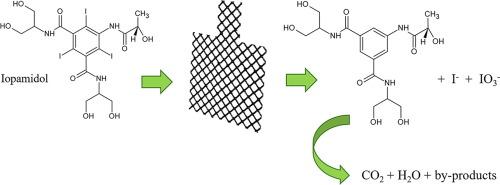探索碘化对比剂碘帕米多在不同电极材料上的电氧化作用,用于废水处理
IF 9
1区 工程技术
Q1 ENGINEERING, CHEMICAL
引用次数: 0
摘要
水中新出现的污染物对环境和人类健康构成严重威胁,强调需要开发有效的处理工艺。本文研究了碘化有机污染物iopamidol (IOPA)在不同电极材料上的电化学降解及其副产物的形成,包括工业阳极(Ti/Pt和Si/BDD)和合成的Ti/SnO2-Sb-Pt(13 %)电极。采用循环伏安法、电化学阻抗谱法和压滤反应器恒流实验研究了其在Na2SO4中的电化学行为和催化活性。结果表明,通过阳极处理,包括直接氧化途径和ohs介导的氧化途径,所研究的所有阳极都可以有效地降解IOPA。电解3 h后,所有电极的降解效率均大于80 %,Si/BDD是效率最高的阳极。副产物HPLC/MS和离子色谱分析表明,IOPA的选择性脱卤是主要的反应途径,产生无毒的脱碘有机化合物。Si/BDD的非选择性和高氧化性导致矿化迅速和完全,但促进了处理后残渣中有毒氧化剂和大部分氧化无机产物的积累。相比之下,与含pt电极相关的较低但更可控的氧化条件使污染物能够转化为有价值的化合物并产生无毒的水残。在Ti/SnO2-Sb-Pt(13. %)中,Pt和SnO2-Sb基体分别促进了IOPA相互作用和OHs的生成,并且其相对较低的成本使其成为重新评价或消除碘化有机造反差剂的良好候选阳极。本文章由计算机程序翻译,如有差异,请以英文原文为准。

Exploring the electro-oxidation of the iodinated contrast iopamidol on different electrode materials for wastewater treatment
Emerging contaminants in water pose a serious threat to the environment and human health, stressing the need of developing efficient treatment processes. In this work, the electrochemical degradation of iopamidol (IOPA), as model iodinated organic pollutant, and the formation of its by-products were investigated on different electrode materials, including commercial anodes (Ti/Pt and Si/BDD) and a synthetized Ti/SnO2-Sb-Pt(13 %) electrode. The electrochemical behaviour and catalytic activity were studied in Na2SO4 by cyclic voltammetry, electrochemical impedance spectroscopy, and galvanostatic experiments in a filter-press reactor. The results show that IOPA can be effectively degraded with all the studied anodes by anodic treatment, involving both the direct and  OHs-mediated oxidation routes. The degradation efficiency achieved after 3 h of electrolysis was found greater than 80 % for all electrodes, being Si/BDD the most efficient anode. By-products analyses with HPLC/MS and ionic chromatography demonstrate the selective dehalogenation of IOPA as the main reaction pathway, giving rise to the formation of non-toxic deiodinated organic compounds. The unselective and highly oxidizing capability of Si/BDD results in rapid and complete mineralization but promotes the accumulation of toxic oxidants and most oxidized inorganic products in the treated residue. By contrast, the lower but more controllable oxidative conditions associated to Pt-containing electrodes enable the conversion of pollutants into valuable compounds and the production of non-toxic aqueous residues. The promoted IOPA interaction and
OHs-mediated oxidation routes. The degradation efficiency achieved after 3 h of electrolysis was found greater than 80 % for all electrodes, being Si/BDD the most efficient anode. By-products analyses with HPLC/MS and ionic chromatography demonstrate the selective dehalogenation of IOPA as the main reaction pathway, giving rise to the formation of non-toxic deiodinated organic compounds. The unselective and highly oxidizing capability of Si/BDD results in rapid and complete mineralization but promotes the accumulation of toxic oxidants and most oxidized inorganic products in the treated residue. By contrast, the lower but more controllable oxidative conditions associated to Pt-containing electrodes enable the conversion of pollutants into valuable compounds and the production of non-toxic aqueous residues. The promoted IOPA interaction and  OHs generation induced by Pt and the SnO2-Sb matrix, respectively, observed for Ti/SnO2-Sb-Pt(13 %), together with its comparatively lower cost, make this anode a good candidate to revalorize or eliminate iodinated organic contrast media.
OHs generation induced by Pt and the SnO2-Sb matrix, respectively, observed for Ti/SnO2-Sb-Pt(13 %), together with its comparatively lower cost, make this anode a good candidate to revalorize or eliminate iodinated organic contrast media.
 OHs-mediated oxidation routes. The degradation efficiency achieved after 3 h of electrolysis was found greater than 80 % for all electrodes, being Si/BDD the most efficient anode. By-products analyses with HPLC/MS and ionic chromatography demonstrate the selective dehalogenation of IOPA as the main reaction pathway, giving rise to the formation of non-toxic deiodinated organic compounds. The unselective and highly oxidizing capability of Si/BDD results in rapid and complete mineralization but promotes the accumulation of toxic oxidants and most oxidized inorganic products in the treated residue. By contrast, the lower but more controllable oxidative conditions associated to Pt-containing electrodes enable the conversion of pollutants into valuable compounds and the production of non-toxic aqueous residues. The promoted IOPA interaction and
OHs-mediated oxidation routes. The degradation efficiency achieved after 3 h of electrolysis was found greater than 80 % for all electrodes, being Si/BDD the most efficient anode. By-products analyses with HPLC/MS and ionic chromatography demonstrate the selective dehalogenation of IOPA as the main reaction pathway, giving rise to the formation of non-toxic deiodinated organic compounds. The unselective and highly oxidizing capability of Si/BDD results in rapid and complete mineralization but promotes the accumulation of toxic oxidants and most oxidized inorganic products in the treated residue. By contrast, the lower but more controllable oxidative conditions associated to Pt-containing electrodes enable the conversion of pollutants into valuable compounds and the production of non-toxic aqueous residues. The promoted IOPA interaction and  OHs generation induced by Pt and the SnO2-Sb matrix, respectively, observed for Ti/SnO2-Sb-Pt(13 %), together with its comparatively lower cost, make this anode a good candidate to revalorize or eliminate iodinated organic contrast media.
OHs generation induced by Pt and the SnO2-Sb matrix, respectively, observed for Ti/SnO2-Sb-Pt(13 %), together with its comparatively lower cost, make this anode a good candidate to revalorize or eliminate iodinated organic contrast media.
求助全文
通过发布文献求助,成功后即可免费获取论文全文。
去求助
来源期刊

Separation and Purification Technology
工程技术-工程:化工
CiteScore
14.00
自引率
12.80%
发文量
2347
审稿时长
43 days
期刊介绍:
Separation and Purification Technology is a premier journal committed to sharing innovative methods for separation and purification in chemical and environmental engineering, encompassing both homogeneous solutions and heterogeneous mixtures. Our scope includes the separation and/or purification of liquids, vapors, and gases, as well as carbon capture and separation techniques. However, it's important to note that methods solely intended for analytical purposes are not within the scope of the journal. Additionally, disciplines such as soil science, polymer science, and metallurgy fall outside the purview of Separation and Purification Technology. Join us in advancing the field of separation and purification methods for sustainable solutions in chemical and environmental engineering.
 求助内容:
求助内容: 应助结果提醒方式:
应助结果提醒方式:


